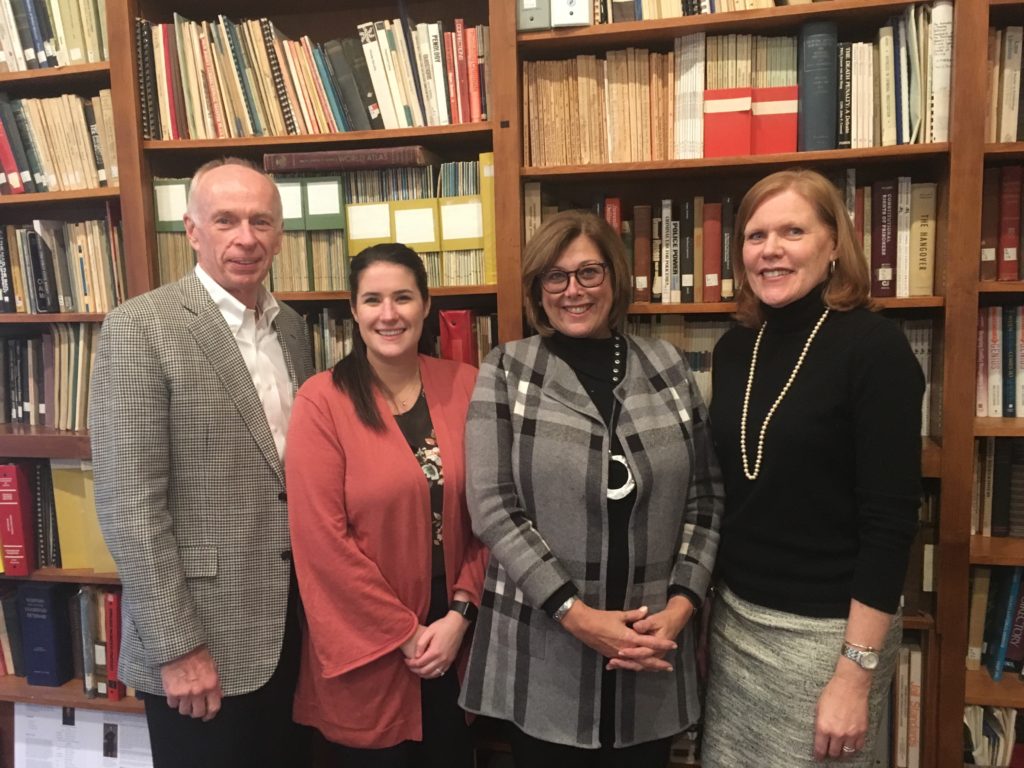
Left to right: CRJ President and CEO John Larivee, CJI Deputy Director of Adult Policy Colby Dawley, Canada Parole Board Chairperson Jennifer Oades, and CJI Executive Director Christine Cole at CRJ's headquarters in February.
BOSTON, Mass. – Sitting across a conference table from a 24-year-old man looking forward to going home after being incarcerated, Jennifer Oades sounded like she was at a typical day at work.
Oades, the head of Canada’s parole board, and the young man chatted about the construction job waiting for him back home, the support he’s received from his family, and his commitment to drug treatment. Finally, she asked whether he thinks he’ll get into trouble after his release from a federal halfway house in a few weeks.
“No, I’m not doing that,” he said, as Oades smiled and nodded. “I got too much knowledge, too much going for me.”

Oades, center, visits CRJ’s Coolidge House reentry center in Boston in February.
But Oades was a few hundred miles out of her jurisdiction. That February afternoon she was at the Coolidge House reentry center in Boston, part of a two-day visit with Community Resources for Justice leaders during an international trip that Oades planned to gather information about good practices in community reintegration efforts.
“I’ve been doing a lot of fact-finding because there’s always room to improve,” Oades said during her visit. “There are a few organizations in the U.S.A. that are doing good work, and I thought I needed to see what they’re doing.”
Oades is one year into a five-year term as chairperson of the Parole Board of Canada, which decides when inmates in the federal corrections system can move from prison to a community-based reentry center or back home. Her trip included a stop in New Jersey to visit reentry programs run by Volunteers of America Delaware Valley before heading up to Boston to meet with CRJ officials and see the organization’s programs firsthand.
Canada’s corrections system is much smaller than the United States’, with a combined population of incarcerated individuals and those on parole of about 33,000, smaller than Colorado’s population of prisoners and parolees. But Oades and CRJ officials found plenty of overlap in charting changes in their respective criminal justice systems since the 1980s: a wave of tough-on-crime policies followed by increasing prison populations, sinking parole rates, and larger numbers of defendants being held pre-trial.
Canada and many parts of the United States are also seeing a sharp uptick in the number of women being sent to prison, an area of special interest for Oades, who previously served as the Correctional Service of Canada’s deputy commissioner for women.

Oades, at right, visits CRJ’s Houston House in Pawtucket, Rhode Island, in February.
But those challenges have also brought innovations, including new strategies to streamline parole processes, recognize and respond to individuals with behavioral health issues in the criminal justice system, and better prepare individuals to transition back into the community after incarceration. Last year, Massachusetts saw public reinvestment in reentry support for individuals returning to the community from incarceration after decades of declining resources and programs being forced to close.
CRJ officials filled Oades in on the successful campaign to include $5 million in the 2019 state budget – up from $90,000 in prior years – dedicated to community-based residential reentry programs. A coalition of defense attorneys, prosecutors, law enforcement officials, elected officials, community leaders, and others advocacy raised awareness and prompted the state Legislature to act.
“We didn’t stop. We kept going and talking, and we’re still talking,” said Ellen Donnarumma, CRJ’s vice president for Justice Services. “We have to get reentry back on the menu of options.”
CRJ President & CEO John Larivee said reentry programs based in the community have the greatest positive impact on helping people restart their lives and remain crime-free.
“It’s the programs in the community that really reduce recidivism,” he said.
Canada has a robust system of community-based halfway houses, and Oades applauded the success in Massachusetts reentry funding.
“It’s a great continuing story,” she said.
Oades also left with some potential ideas to consider replicating after speaking with staff from the Crime and Justice Institute, a division of Community Resources for Justice that partners with criminal justice organizations at all levels to improve outcomes, including establishing community outreach initiatives to improve the sharing of information on the work of the Parole Board.